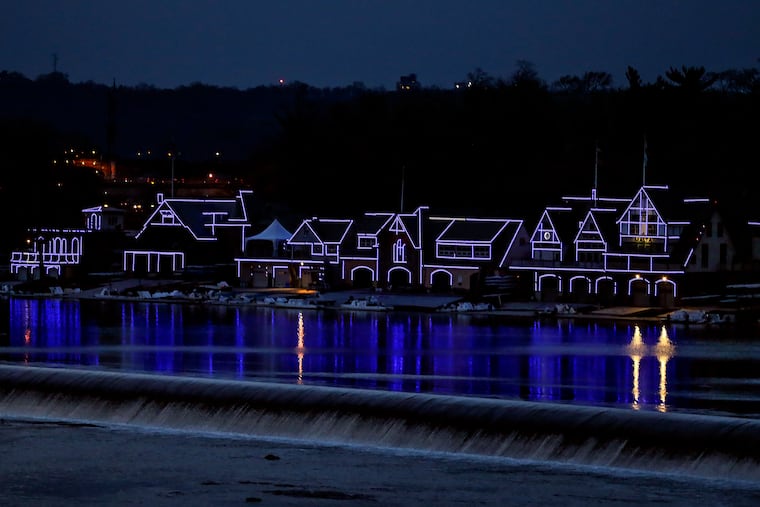Boathouse Row lights along the Schuylkill are about to go dark for a major upgrade
Longwood Gardens on the Schuylkill? The new lights will be programmed for 16 million color changes, officials said.

Philadelphia’s nightscape is about to lose a signature feature of its magic. The lights illuminating Boathouse Row along the Schuylkill for more than four decades are going dark, perhaps until the end of the year, for what officials say will be a transformative upgrade.
The overhaul project will begin Monday — coincidentally the first day of spring — and will involve removing all the bulbs and replacing them with 6,400 LED bulbs that will be programmed to change colors in 16 million possible combinations with the capability to “dance,” said the city Fairmount Park Conservancy, the project lead, and the city Parks and Recreation Department.
Removing the old bulbs also will allow for structural repairs on the historic Victorian houses where the lights have made some areas inaccessible, they said. Officials estimated that it would take eight months to finish the work.
“The hope is that it will be completed before the winter holidays,” said Bonnie Mueller, who is commodore of the Schuylkill Navy, which also is involved in the $2.1 million project, funded primarily by the Joanna McNeil Trust.
» READ MORE: ‘A labor of love’: The lives of Boathouse Row’s little-known inhabitants
The project designer is the Lighting Practice, which has offices in Philadelphia, Dallas, and New York City.
The tradition of lighting the rowing-club houses began in October 1979 — in time for the visit of Pope John Paul II. The designer was the legendary Ray Grenald, and the lights evoked “a magical fairyland,” in the words of Inquirer architecture critic Inga Saffron.
“The lighting was intended to put an exclamation point on the houses,” Grenald said. “It is classic architecture.”
While the postcard image of the lighted houses quickly became popular, the project had encountered some resistance.
Grenald recalled at the time that when he approached boathouse officials about the project some were enthusiastic and others “appalled.”
» READ MORE: Long-delayed dredge of Schuylkill in front of Boathouse Row begins, as sludge gets pumped out in $13M project
What was then a $55,000 project — about $220,000 in today’s dollars — was approved by Mayor Frank L. Rizzo, even though at the time the administration of President Jimmy Carter was campaigning hard for conservation. This was an era of oil shortages, rocketing gas prices, lines at the pump, and anxieties over nuclear energy in the wake of the Three Mile Island disaster.
“The lighting was intended to put an exclamation point on the houses,” Grenald said. “It is classic architecture … but the condition of the houses is enough to make you cry.”
The lights went on for the first time the day the pope arrived, and he passed them on his way to St. Charles Borromeo Seminary.
But over the years they have had their share of technical and maintenance problems. A 1982 Inquirer editorial quoted one observer as saying that the collective effect of the lighting gave the appearance of “a big smile with lots of teeth missing.”
LED lights were installed in 2005; the lights went off for six months, from January to July, for the renovations. They were upgraded in 2016.
“We view the boathouses as a way of beckoning people to the Schuylkill,” said Mueller. “This project ensures that Boathouse Row can remain a beacon.”